Sustainable Tourism Development: A Philippines Case Study Report
VerifiedAdded on 2020/01/07
|20
|3725
|169
Report
AI Summary
This report provides a comprehensive analysis of sustainable tourism in the Philippines, examining the benefits for stakeholders involved in tourism development. It delves into various aspects of tourism planning at different levels (global, national, regional, and sub-regional) and highlights the importance of interactive planning systems. The report explores methods for measuring the impact of tourism, including economic impact models and the STEAM model, while also addressing the need for sustainable development planning. Furthermore, it discusses methods for resolving conflicts of interest, ensuring the well-being of tourism destinations, and analyzing the implications of balancing supply and demand. The report also touches upon moral and ethical issues in enclave tourism and compares current issues associated with tourism development in both developing and emerging destinations. Finally, it offers suggestions for the future development of tourism in the chosen destinations, supported by references.
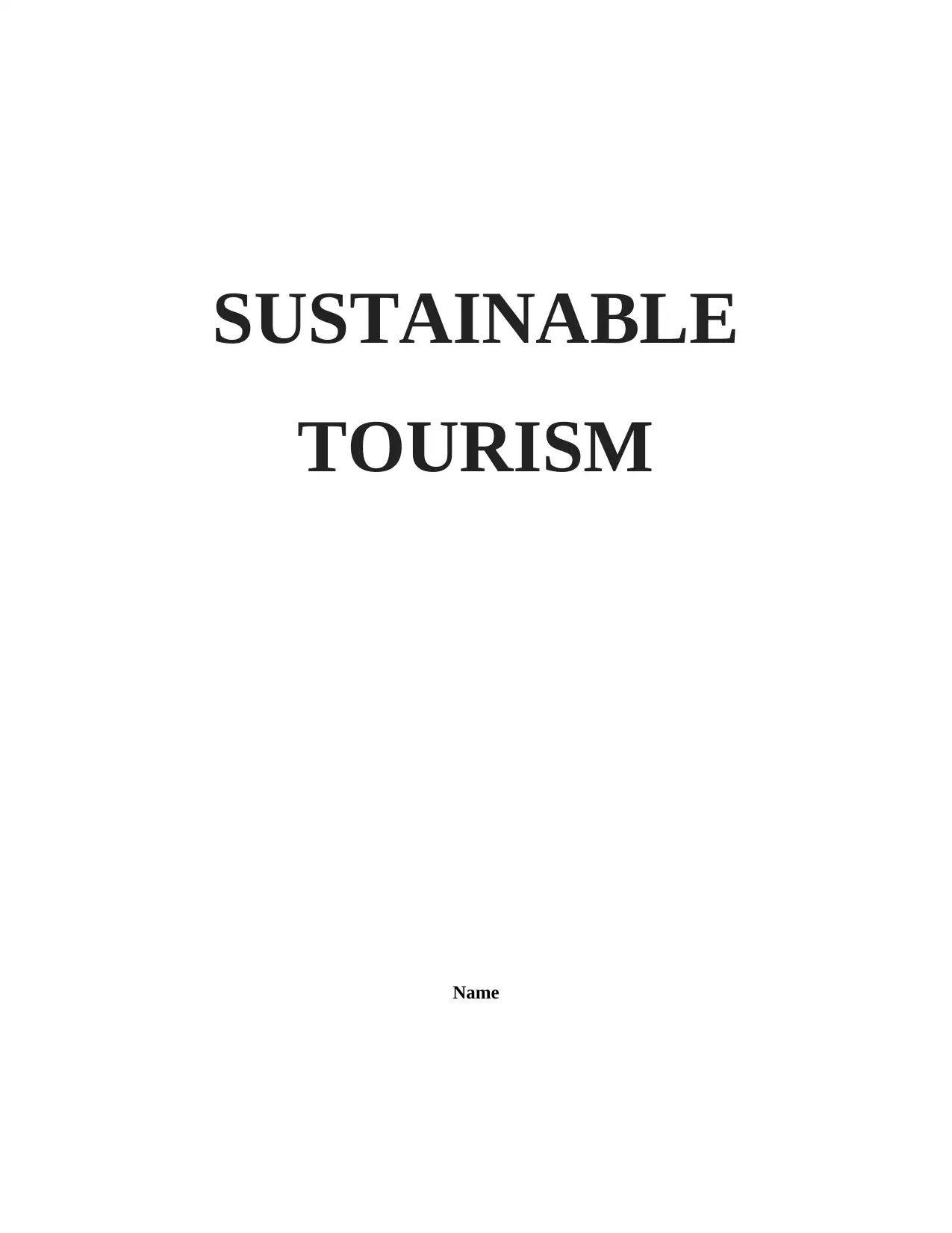
SUSTAINABLE
TOURISM
Name
TOURISM
Name
Paraphrase This Document
Need a fresh take? Get an instant paraphrase of this document with our AI Paraphraser

Lecturer’s name
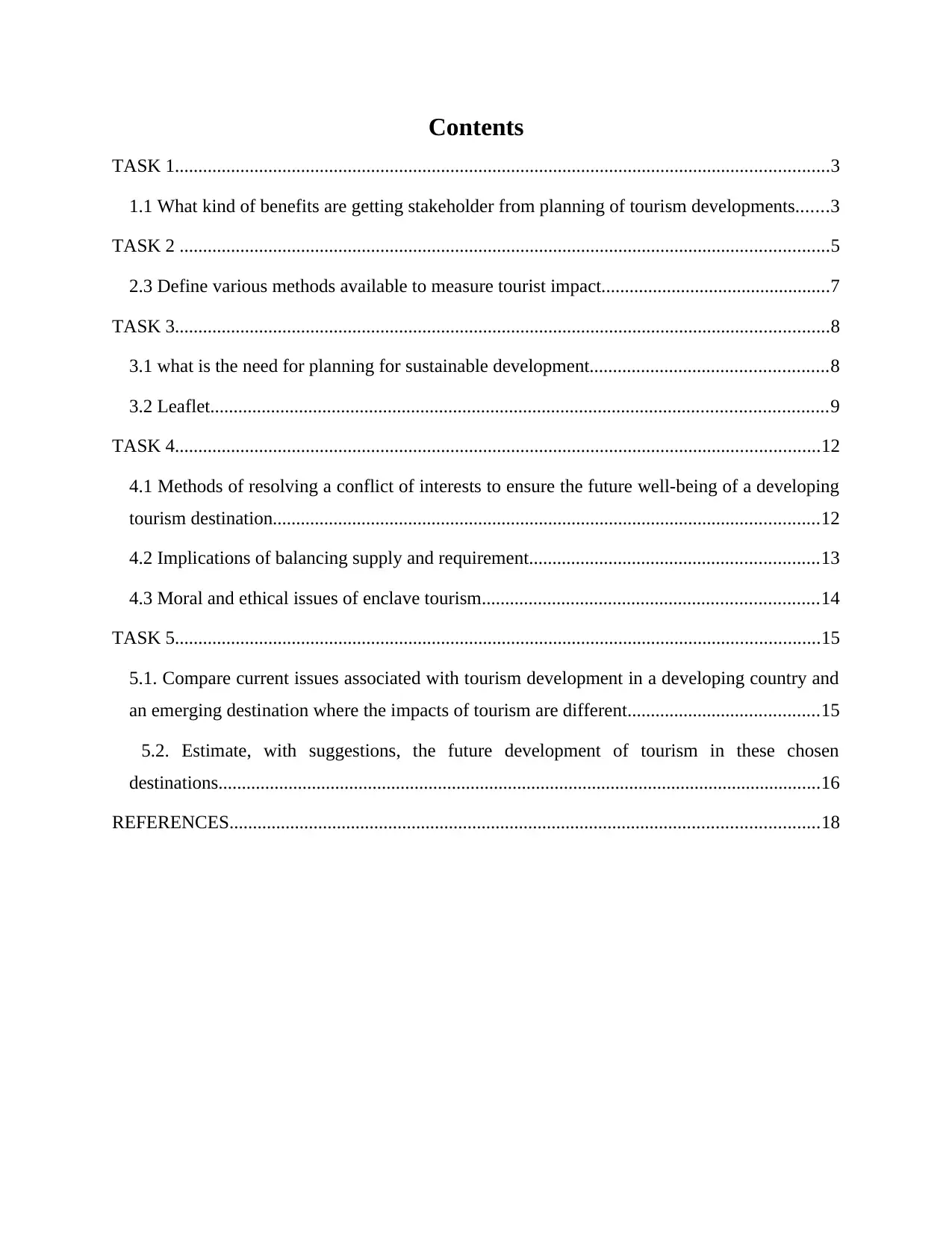
Contents
TASK 1............................................................................................................................................3
1.1 What kind of benefits are getting stakeholder from planning of tourism developments.......3
TASK 2 ...........................................................................................................................................5
2.3 Define various methods available to measure tourist impact.................................................7
TASK 3............................................................................................................................................8
3.1 what is the need for planning for sustainable development...................................................8
3.2 Leaflet....................................................................................................................................9
TASK 4..........................................................................................................................................12
4.1 Methods of resolving a conflict of interests to ensure the future well-being of a developing
tourism destination.....................................................................................................................12
4.2 Implications of balancing supply and requirement..............................................................13
4.3 Moral and ethical issues of enclave tourism........................................................................14
TASK 5..........................................................................................................................................15
5.1. Compare current issues associated with tourism development in a developing country and
an emerging destination where the impacts of tourism are different.........................................15
5.2. Estimate, with suggestions, the future development of tourism in these chosen
destinations.................................................................................................................................16
REFERENCES..............................................................................................................................18
TASK 1............................................................................................................................................3
1.1 What kind of benefits are getting stakeholder from planning of tourism developments.......3
TASK 2 ...........................................................................................................................................5
2.3 Define various methods available to measure tourist impact.................................................7
TASK 3............................................................................................................................................8
3.1 what is the need for planning for sustainable development...................................................8
3.2 Leaflet....................................................................................................................................9
TASK 4..........................................................................................................................................12
4.1 Methods of resolving a conflict of interests to ensure the future well-being of a developing
tourism destination.....................................................................................................................12
4.2 Implications of balancing supply and requirement..............................................................13
4.3 Moral and ethical issues of enclave tourism........................................................................14
TASK 5..........................................................................................................................................15
5.1. Compare current issues associated with tourism development in a developing country and
an emerging destination where the impacts of tourism are different.........................................15
5.2. Estimate, with suggestions, the future development of tourism in these chosen
destinations.................................................................................................................................16
REFERENCES..............................................................................................................................18
⊘ This is a preview!⊘
Do you want full access?
Subscribe today to unlock all pages.

Trusted by 1+ million students worldwide
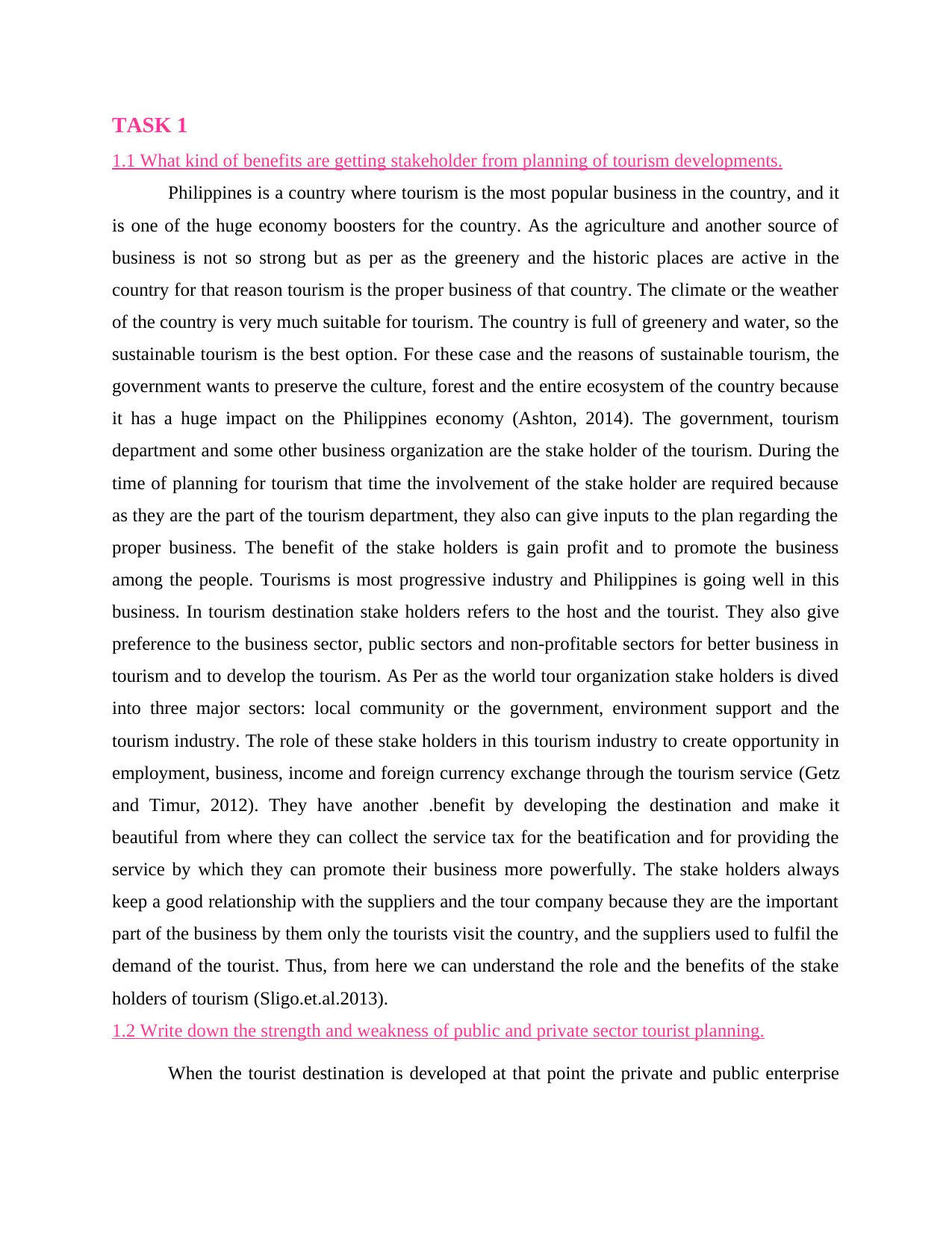
TASK 1
1.1 What kind of benefits are getting stakeholder from planning of tourism developments.
Philippines is a country where tourism is the most popular business in the country, and it
is one of the huge economy boosters for the country. As the agriculture and another source of
business is not so strong but as per as the greenery and the historic places are active in the
country for that reason tourism is the proper business of that country. The climate or the weather
of the country is very much suitable for tourism. The country is full of greenery and water, so the
sustainable tourism is the best option. For these case and the reasons of sustainable tourism, the
government wants to preserve the culture, forest and the entire ecosystem of the country because
it has a huge impact on the Philippines economy (Ashton, 2014). The government, tourism
department and some other business organization are the stake holder of the tourism. During the
time of planning for tourism that time the involvement of the stake holder are required because
as they are the part of the tourism department, they also can give inputs to the plan regarding the
proper business. The benefit of the stake holders is gain profit and to promote the business
among the people. Tourisms is most progressive industry and Philippines is going well in this
business. In tourism destination stake holders refers to the host and the tourist. They also give
preference to the business sector, public sectors and non-profitable sectors for better business in
tourism and to develop the tourism. As Per as the world tour organization stake holders is dived
into three major sectors: local community or the government, environment support and the
tourism industry. The role of these stake holders in this tourism industry to create opportunity in
employment, business, income and foreign currency exchange through the tourism service (Getz
and Timur, 2012). They have another .benefit by developing the destination and make it
beautiful from where they can collect the service tax for the beatification and for providing the
service by which they can promote their business more powerfully. The stake holders always
keep a good relationship with the suppliers and the tour company because they are the important
part of the business by them only the tourists visit the country, and the suppliers used to fulfil the
demand of the tourist. Thus, from here we can understand the role and the benefits of the stake
holders of tourism (Sligo.et.al.2013).
1.2 Write down the strength and weakness of public and private sector tourist planning.
When the tourist destination is developed at that point the private and public enterprise
1.1 What kind of benefits are getting stakeholder from planning of tourism developments.
Philippines is a country where tourism is the most popular business in the country, and it
is one of the huge economy boosters for the country. As the agriculture and another source of
business is not so strong but as per as the greenery and the historic places are active in the
country for that reason tourism is the proper business of that country. The climate or the weather
of the country is very much suitable for tourism. The country is full of greenery and water, so the
sustainable tourism is the best option. For these case and the reasons of sustainable tourism, the
government wants to preserve the culture, forest and the entire ecosystem of the country because
it has a huge impact on the Philippines economy (Ashton, 2014). The government, tourism
department and some other business organization are the stake holder of the tourism. During the
time of planning for tourism that time the involvement of the stake holder are required because
as they are the part of the tourism department, they also can give inputs to the plan regarding the
proper business. The benefit of the stake holders is gain profit and to promote the business
among the people. Tourisms is most progressive industry and Philippines is going well in this
business. In tourism destination stake holders refers to the host and the tourist. They also give
preference to the business sector, public sectors and non-profitable sectors for better business in
tourism and to develop the tourism. As Per as the world tour organization stake holders is dived
into three major sectors: local community or the government, environment support and the
tourism industry. The role of these stake holders in this tourism industry to create opportunity in
employment, business, income and foreign currency exchange through the tourism service (Getz
and Timur, 2012). They have another .benefit by developing the destination and make it
beautiful from where they can collect the service tax for the beatification and for providing the
service by which they can promote their business more powerfully. The stake holders always
keep a good relationship with the suppliers and the tour company because they are the important
part of the business by them only the tourists visit the country, and the suppliers used to fulfil the
demand of the tourist. Thus, from here we can understand the role and the benefits of the stake
holders of tourism (Sligo.et.al.2013).
1.2 Write down the strength and weakness of public and private sector tourist planning.
When the tourist destination is developed at that point the private and public enterprise
Paraphrase This Document
Need a fresh take? Get an instant paraphrase of this document with our AI Paraphraser
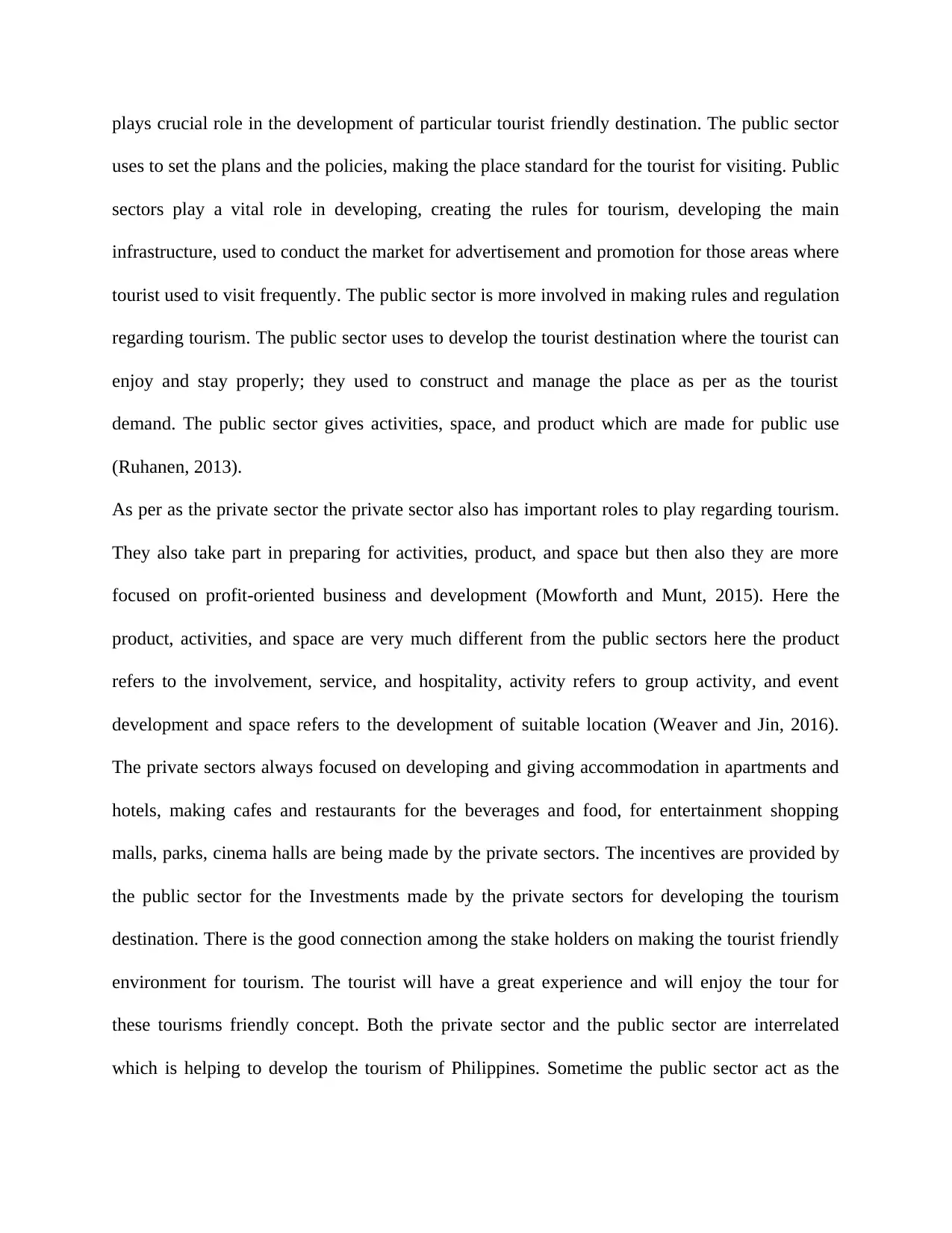
plays crucial role in the development of particular tourist friendly destination. The public sector
uses to set the plans and the policies, making the place standard for the tourist for visiting. Public
sectors play a vital role in developing, creating the rules for tourism, developing the main
infrastructure, used to conduct the market for advertisement and promotion for those areas where
tourist used to visit frequently. The public sector is more involved in making rules and regulation
regarding tourism. The public sector uses to develop the tourist destination where the tourist can
enjoy and stay properly; they used to construct and manage the place as per as the tourist
demand. The public sector gives activities, space, and product which are made for public use
(Ruhanen, 2013).
As per as the private sector the private sector also has important roles to play regarding tourism.
They also take part in preparing for activities, product, and space but then also they are more
focused on profit-oriented business and development (Mowforth and Munt, 2015). Here the
product, activities, and space are very much different from the public sectors here the product
refers to the involvement, service, and hospitality, activity refers to group activity, and event
development and space refers to the development of suitable location (Weaver and Jin, 2016).
The private sectors always focused on developing and giving accommodation in apartments and
hotels, making cafes and restaurants for the beverages and food, for entertainment shopping
malls, parks, cinema halls are being made by the private sectors. The incentives are provided by
the public sector for the Investments made by the private sectors for developing the tourism
destination. There is the good connection among the stake holders on making the tourist friendly
environment for tourism. The tourist will have a great experience and will enjoy the tour for
these tourisms friendly concept. Both the private sector and the public sector are interrelated
which is helping to develop the tourism of Philippines. Sometime the public sector act as the
uses to set the plans and the policies, making the place standard for the tourist for visiting. Public
sectors play a vital role in developing, creating the rules for tourism, developing the main
infrastructure, used to conduct the market for advertisement and promotion for those areas where
tourist used to visit frequently. The public sector is more involved in making rules and regulation
regarding tourism. The public sector uses to develop the tourist destination where the tourist can
enjoy and stay properly; they used to construct and manage the place as per as the tourist
demand. The public sector gives activities, space, and product which are made for public use
(Ruhanen, 2013).
As per as the private sector the private sector also has important roles to play regarding tourism.
They also take part in preparing for activities, product, and space but then also they are more
focused on profit-oriented business and development (Mowforth and Munt, 2015). Here the
product, activities, and space are very much different from the public sectors here the product
refers to the involvement, service, and hospitality, activity refers to group activity, and event
development and space refers to the development of suitable location (Weaver and Jin, 2016).
The private sectors always focused on developing and giving accommodation in apartments and
hotels, making cafes and restaurants for the beverages and food, for entertainment shopping
malls, parks, cinema halls are being made by the private sectors. The incentives are provided by
the public sector for the Investments made by the private sectors for developing the tourism
destination. There is the good connection among the stake holders on making the tourist friendly
environment for tourism. The tourist will have a great experience and will enjoy the tour for
these tourisms friendly concept. Both the private sector and the public sector are interrelated
which is helping to develop the tourism of Philippines. Sometime the public sector act as the
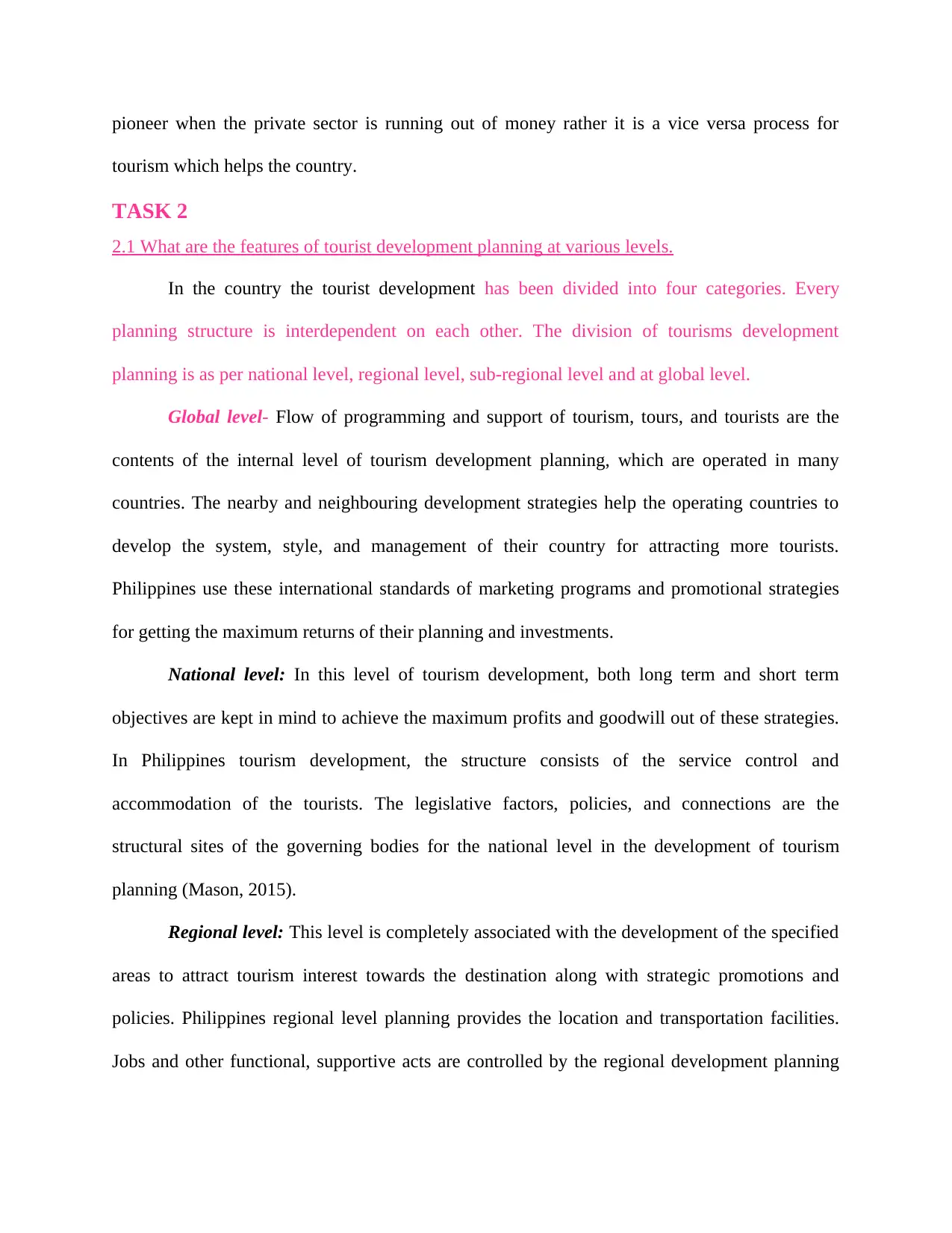
pioneer when the private sector is running out of money rather it is a vice versa process for
tourism which helps the country.
TASK 2
2.1 What are the features of tourist development planning at various levels.
In the country the tourist development has been divided into four categories. Every
planning structure is interdependent on each other. The division of tourisms development
planning is as per national level, regional level, sub-regional level and at global level.
Global level- Flow of programming and support of tourism, tours, and tourists are the
contents of the internal level of tourism development planning, which are operated in many
countries. The nearby and neighbouring development strategies help the operating countries to
develop the system, style, and management of their country for attracting more tourists.
Philippines use these international standards of marketing programs and promotional strategies
for getting the maximum returns of their planning and investments.
National level: In this level of tourism development, both long term and short term
objectives are kept in mind to achieve the maximum profits and goodwill out of these strategies.
In Philippines tourism development, the structure consists of the service control and
accommodation of the tourists. The legislative factors, policies, and connections are the
structural sites of the governing bodies for the national level in the development of tourism
planning (Mason, 2015).
Regional level: This level is completely associated with the development of the specified
areas to attract tourism interest towards the destination along with strategic promotions and
policies. Philippines regional level planning provides the location and transportation facilities.
Jobs and other functional, supportive acts are controlled by the regional development planning
tourism which helps the country.
TASK 2
2.1 What are the features of tourist development planning at various levels.
In the country the tourist development has been divided into four categories. Every
planning structure is interdependent on each other. The division of tourisms development
planning is as per national level, regional level, sub-regional level and at global level.
Global level- Flow of programming and support of tourism, tours, and tourists are the
contents of the internal level of tourism development planning, which are operated in many
countries. The nearby and neighbouring development strategies help the operating countries to
develop the system, style, and management of their country for attracting more tourists.
Philippines use these international standards of marketing programs and promotional strategies
for getting the maximum returns of their planning and investments.
National level: In this level of tourism development, both long term and short term
objectives are kept in mind to achieve the maximum profits and goodwill out of these strategies.
In Philippines tourism development, the structure consists of the service control and
accommodation of the tourists. The legislative factors, policies, and connections are the
structural sites of the governing bodies for the national level in the development of tourism
planning (Mason, 2015).
Regional level: This level is completely associated with the development of the specified
areas to attract tourism interest towards the destination along with strategic promotions and
policies. Philippines regional level planning provides the location and transportation facilities.
Jobs and other functional, supportive acts are controlled by the regional development planning
⊘ This is a preview!⊘
Do you want full access?
Subscribe today to unlock all pages.

Trusted by 1+ million students worldwide
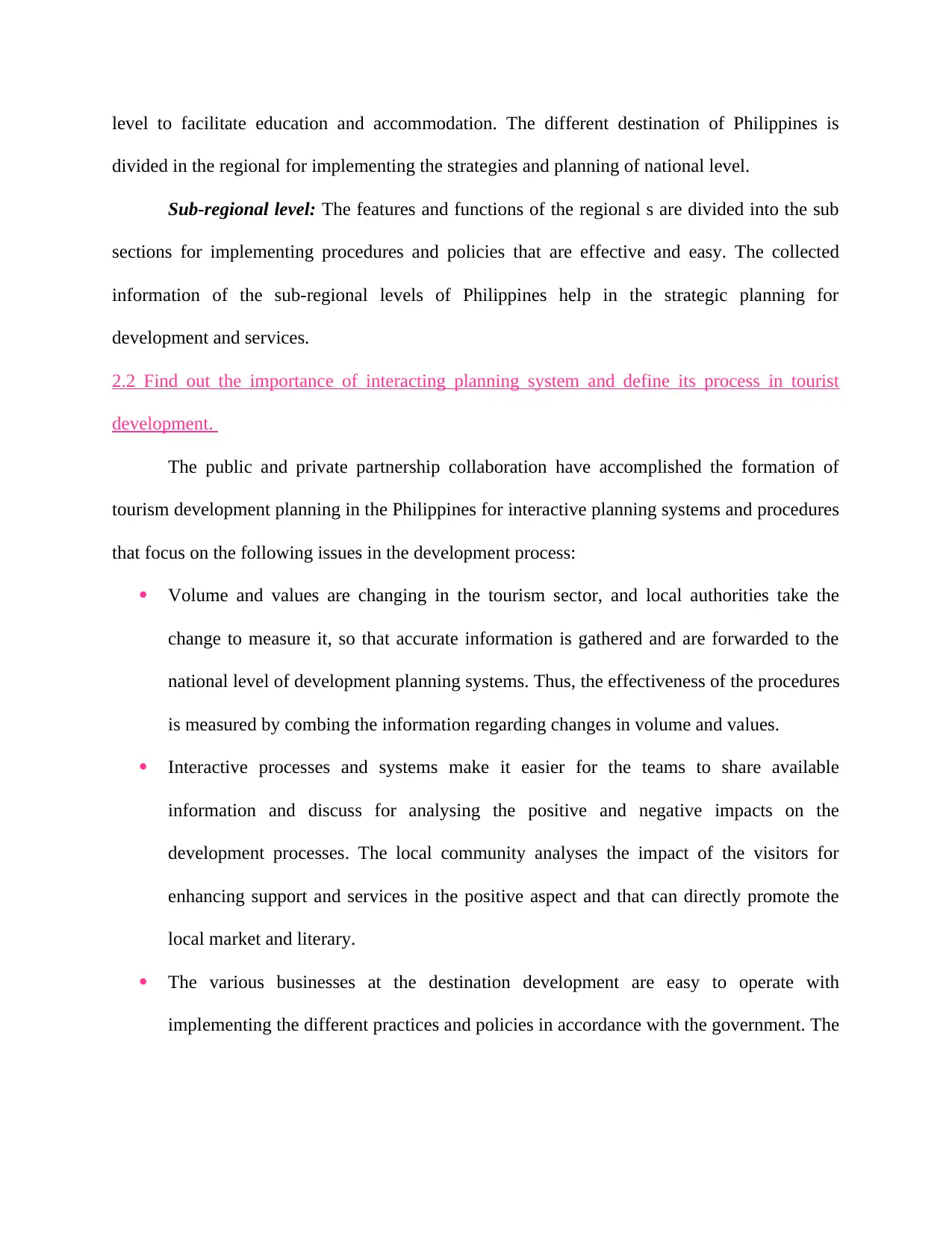
level to facilitate education and accommodation. The different destination of Philippines is
divided in the regional for implementing the strategies and planning of national level.
Sub-regional level: The features and functions of the regional s are divided into the sub
sections for implementing procedures and policies that are effective and easy. The collected
information of the sub-regional levels of Philippines help in the strategic planning for
development and services.
2.2 Find out the importance of interacting planning system and define its process in tourist
development.
The public and private partnership collaboration have accomplished the formation of
tourism development planning in the Philippines for interactive planning systems and procedures
that focus on the following issues in the development process:
Volume and values are changing in the tourism sector, and local authorities take the
change to measure it, so that accurate information is gathered and are forwarded to the
national level of development planning systems. Thus, the effectiveness of the procedures
is measured by combing the information regarding changes in volume and values.
Interactive processes and systems make it easier for the teams to share available
information and discuss for analysing the positive and negative impacts on the
development processes. The local community analyses the impact of the visitors for
enhancing support and services in the positive aspect and that can directly promote the
local market and literary.
The various businesses at the destination development are easy to operate with
implementing the different practices and policies in accordance with the government. The
divided in the regional for implementing the strategies and planning of national level.
Sub-regional level: The features and functions of the regional s are divided into the sub
sections for implementing procedures and policies that are effective and easy. The collected
information of the sub-regional levels of Philippines help in the strategic planning for
development and services.
2.2 Find out the importance of interacting planning system and define its process in tourist
development.
The public and private partnership collaboration have accomplished the formation of
tourism development planning in the Philippines for interactive planning systems and procedures
that focus on the following issues in the development process:
Volume and values are changing in the tourism sector, and local authorities take the
change to measure it, so that accurate information is gathered and are forwarded to the
national level of development planning systems. Thus, the effectiveness of the procedures
is measured by combing the information regarding changes in volume and values.
Interactive processes and systems make it easier for the teams to share available
information and discuss for analysing the positive and negative impacts on the
development processes. The local community analyses the impact of the visitors for
enhancing support and services in the positive aspect and that can directly promote the
local market and literary.
The various businesses at the destination development are easy to operate with
implementing the different practices and policies in accordance with the government. The
Paraphrase This Document
Need a fresh take? Get an instant paraphrase of this document with our AI Paraphraser
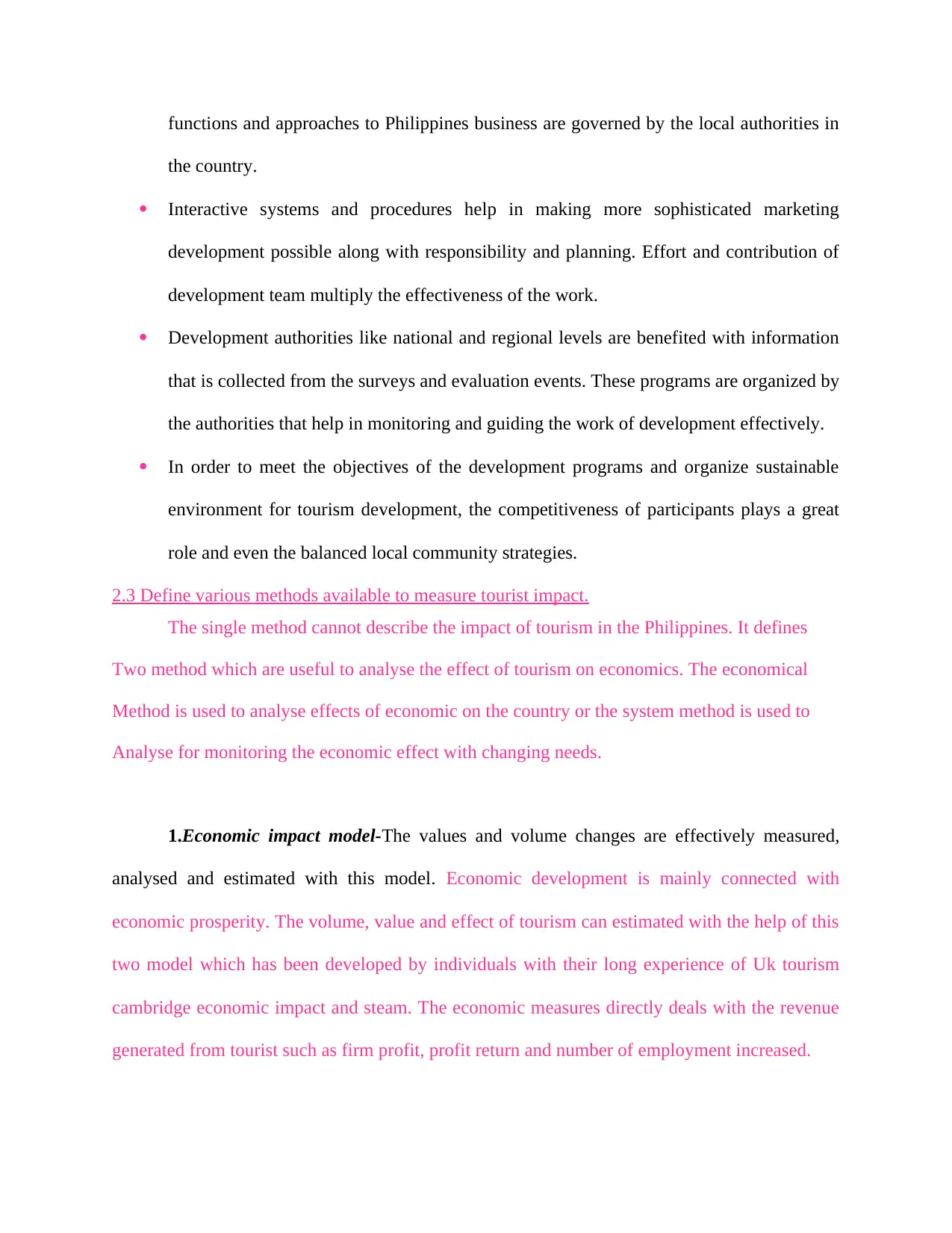
functions and approaches to Philippines business are governed by the local authorities in
the country.
Interactive systems and procedures help in making more sophisticated marketing
development possible along with responsibility and planning. Effort and contribution of
development team multiply the effectiveness of the work.
Development authorities like national and regional levels are benefited with information
that is collected from the surveys and evaluation events. These programs are organized by
the authorities that help in monitoring and guiding the work of development effectively.
In order to meet the objectives of the development programs and organize sustainable
environment for tourism development, the competitiveness of participants plays a great
role and even the balanced local community strategies.
2.3 Define various methods available to measure tourist impact.
The single method cannot describe the impact of tourism in the Philippines. It defines
Two method which are useful to analyse the effect of tourism on economics. The economical
Method is used to analyse effects of economic on the country or the system method is used to
Analyse for monitoring the economic effect with changing needs.
1.Economic impact model-The values and volume changes are effectively measured,
analysed and estimated with this model. Economic development is mainly connected with
economic prosperity. The volume, value and effect of tourism can estimated with the help of this
two model which has been developed by individuals with their long experience of Uk tourism
cambridge economic impact and steam. The economic measures directly deals with the revenue
generated from tourist such as firm profit, profit return and number of employment increased.
the country.
Interactive systems and procedures help in making more sophisticated marketing
development possible along with responsibility and planning. Effort and contribution of
development team multiply the effectiveness of the work.
Development authorities like national and regional levels are benefited with information
that is collected from the surveys and evaluation events. These programs are organized by
the authorities that help in monitoring and guiding the work of development effectively.
In order to meet the objectives of the development programs and organize sustainable
environment for tourism development, the competitiveness of participants plays a great
role and even the balanced local community strategies.
2.3 Define various methods available to measure tourist impact.
The single method cannot describe the impact of tourism in the Philippines. It defines
Two method which are useful to analyse the effect of tourism on economics. The economical
Method is used to analyse effects of economic on the country or the system method is used to
Analyse for monitoring the economic effect with changing needs.
1.Economic impact model-The values and volume changes are effectively measured,
analysed and estimated with this model. Economic development is mainly connected with
economic prosperity. The volume, value and effect of tourism can estimated with the help of this
two model which has been developed by individuals with their long experience of Uk tourism
cambridge economic impact and steam. The economic measures directly deals with the revenue
generated from tourist such as firm profit, profit return and number of employment increased.
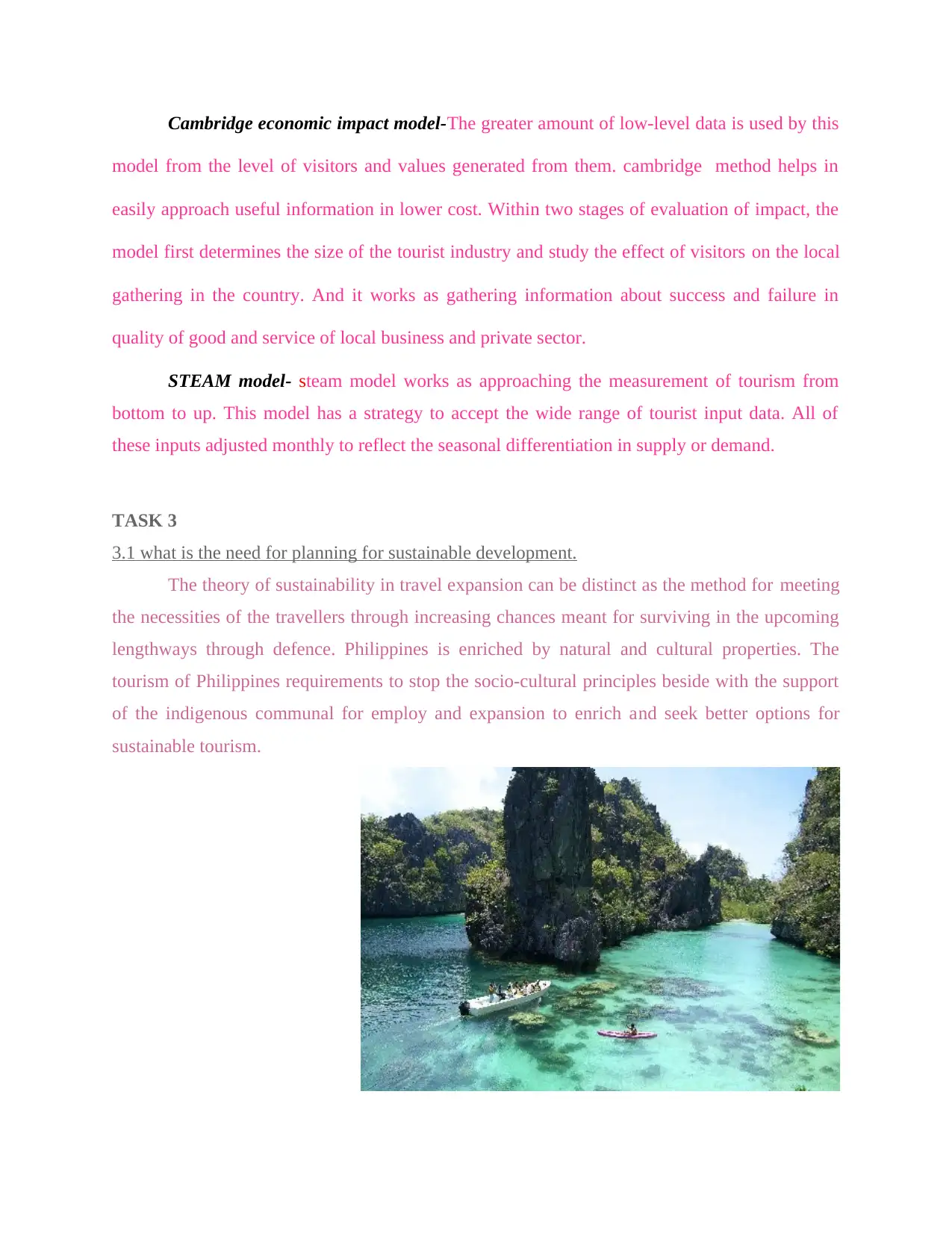
Cambridge economic impact model-The greater amount of low-level data is used by this
model from the level of visitors and values generated from them. cambridge method helps in
easily approach useful information in lower cost. Within two stages of evaluation of impact, the
model first determines the size of the tourist industry and study the effect of visitors on the local
gathering in the country. And it works as gathering information about success and failure in
quality of good and service of local business and private sector.
STEAM model- steam model works as approaching the measurement of tourism from
bottom to up. This model has a strategy to accept the wide range of tourist input data. All of
these inputs adjusted monthly to reflect the seasonal differentiation in supply or demand.
TASK 3
3.1 what is the need for planning for sustainable development.
The theory of sustainability in travel expansion can be distinct as the method for meeting
the necessities of the travellers through increasing chances meant for surviving in the upcoming
lengthways through defence. Philippines is enriched by natural and cultural properties. The
tourism of Philippines requirements to stop the socio-cultural principles beside with the support
of the indigenous communal for employ and expansion to enrich and seek better options for
sustainable tourism.
model from the level of visitors and values generated from them. cambridge method helps in
easily approach useful information in lower cost. Within two stages of evaluation of impact, the
model first determines the size of the tourist industry and study the effect of visitors on the local
gathering in the country. And it works as gathering information about success and failure in
quality of good and service of local business and private sector.
STEAM model- steam model works as approaching the measurement of tourism from
bottom to up. This model has a strategy to accept the wide range of tourist input data. All of
these inputs adjusted monthly to reflect the seasonal differentiation in supply or demand.
TASK 3
3.1 what is the need for planning for sustainable development.
The theory of sustainability in travel expansion can be distinct as the method for meeting
the necessities of the travellers through increasing chances meant for surviving in the upcoming
lengthways through defence. Philippines is enriched by natural and cultural properties. The
tourism of Philippines requirements to stop the socio-cultural principles beside with the support
of the indigenous communal for employ and expansion to enrich and seek better options for
sustainable tourism.
⊘ This is a preview!⊘
Do you want full access?
Subscribe today to unlock all pages.

Trusted by 1+ million students worldwide
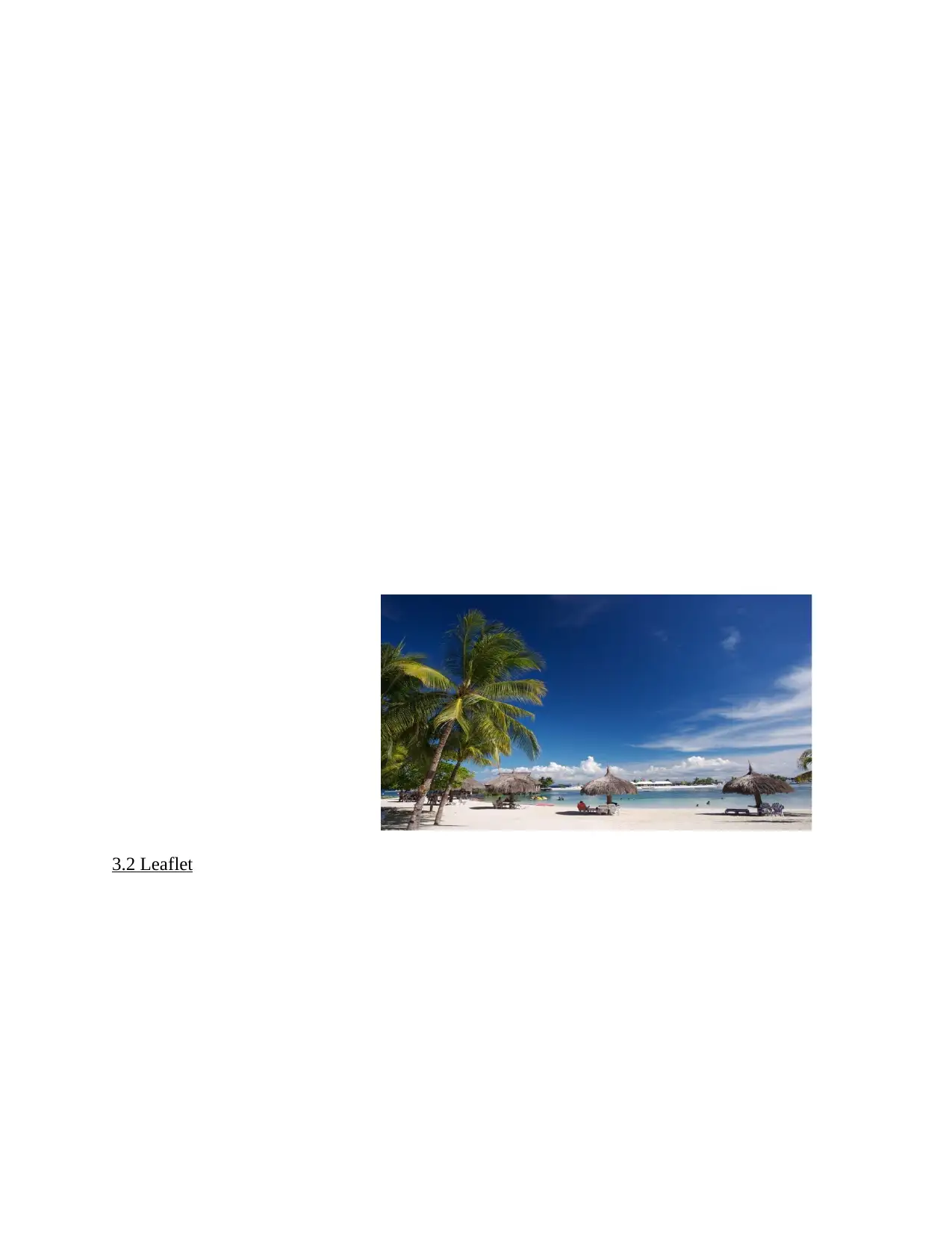
3.2 Leaflet
Paraphrase This Document
Need a fresh take? Get an instant paraphrase of this document with our AI Paraphraser
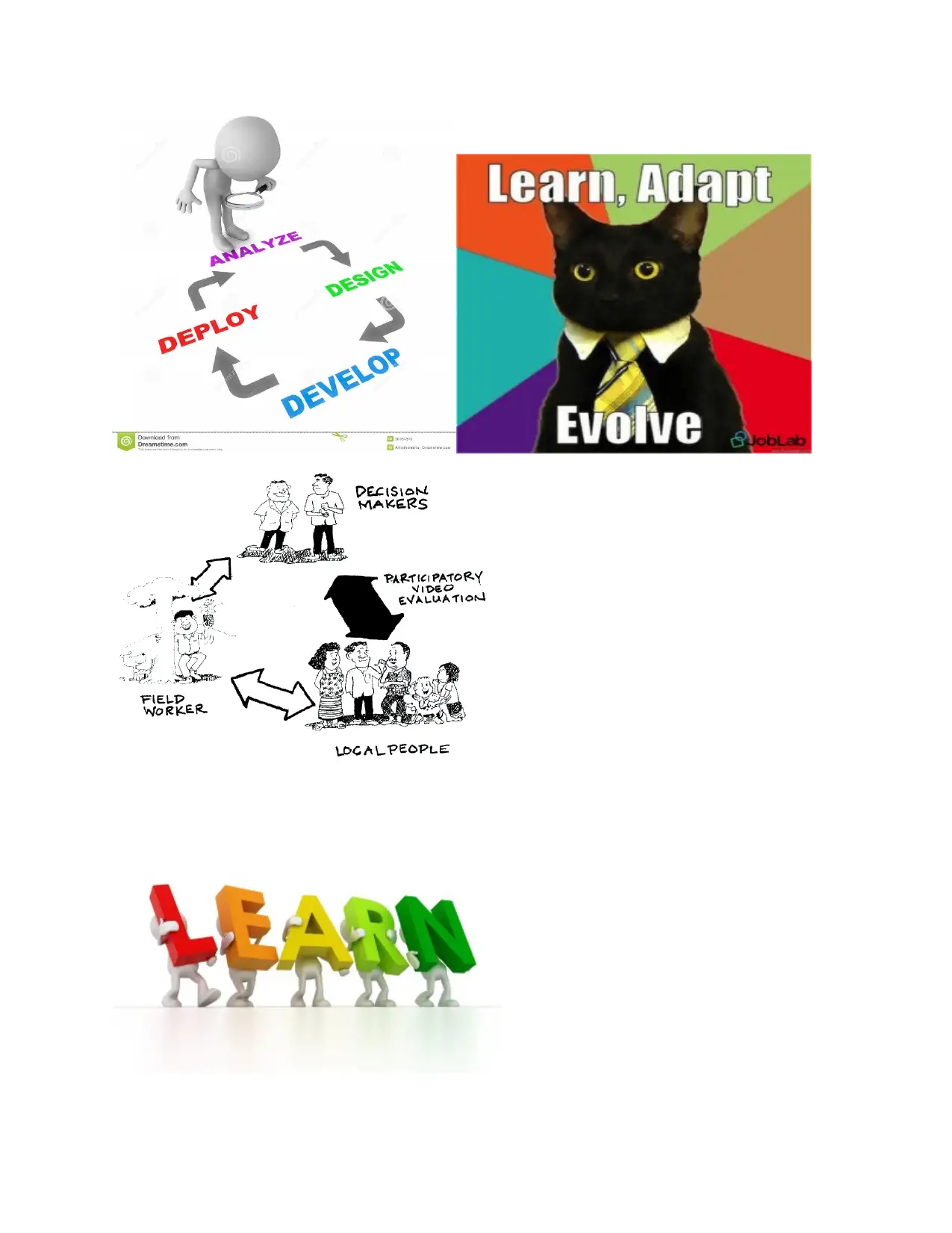

⊘ This is a preview!⊘
Do you want full access?
Subscribe today to unlock all pages.

Trusted by 1+ million students worldwide
1 out of 20
Related Documents
Your All-in-One AI-Powered Toolkit for Academic Success.
+13062052269
info@desklib.com
Available 24*7 on WhatsApp / Email
![[object Object]](/_next/static/media/star-bottom.7253800d.svg)
Unlock your academic potential
Copyright © 2020–2025 A2Z Services. All Rights Reserved. Developed and managed by ZUCOL.





